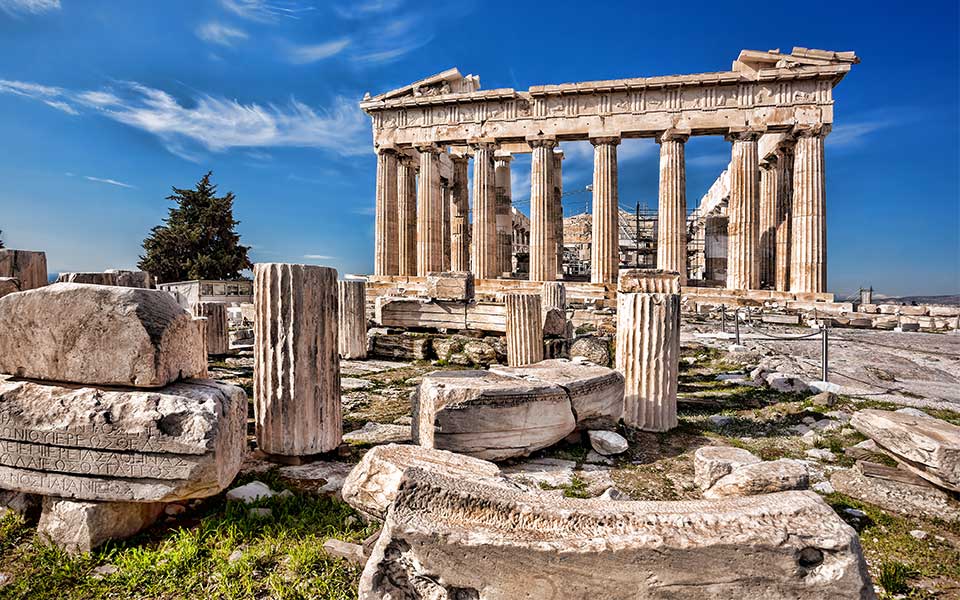April 18 is International Monuments and Sites Day, also known as World Heritage Day, celebrating the work of the International Council on Monuments and Sites (ICOMOS).
Founded in 1965, ICOMOS works for the conservation and protection of cultural heritage sites around the world, and offers advice to UNESCO on World Heritage Sites.
The United Nations Educational, Scientific and Cultural Organization (UNESCO) is a specialized agency of the United Nations aimed at “promoting world peace and security through international cooperation in education, the sciences, and culture.” UNESCO World Heritage Sites are places of importance to cultural or natural heritage as described in the World Heritage Convention, established in 1972.
Greece ratified the convention 43 years ago this year, on July 17, 1981.
As of 2024, there are 19 sites in Greece inscribed on the World Heritage List. The following round-up is a celebration of the incredible richness and diversity of Greek archaeological heritage spanning more than three and a half millennia.
From Bronze Age citadels and the sacred Acropolis of Athens (on which stands the Parthenon, chosen by UNESCO as its official emblem), to Byzantine monasteries and Venetian fortresses, Greece’s ongoing efforts to protect and curate its sites and monuments is testament to the tireless work of archaeologists, conservators and heritage managers across the country.
Greece stands as a beacon for global public awareness for the preservation and enhancement of cultural heritage for future generations.
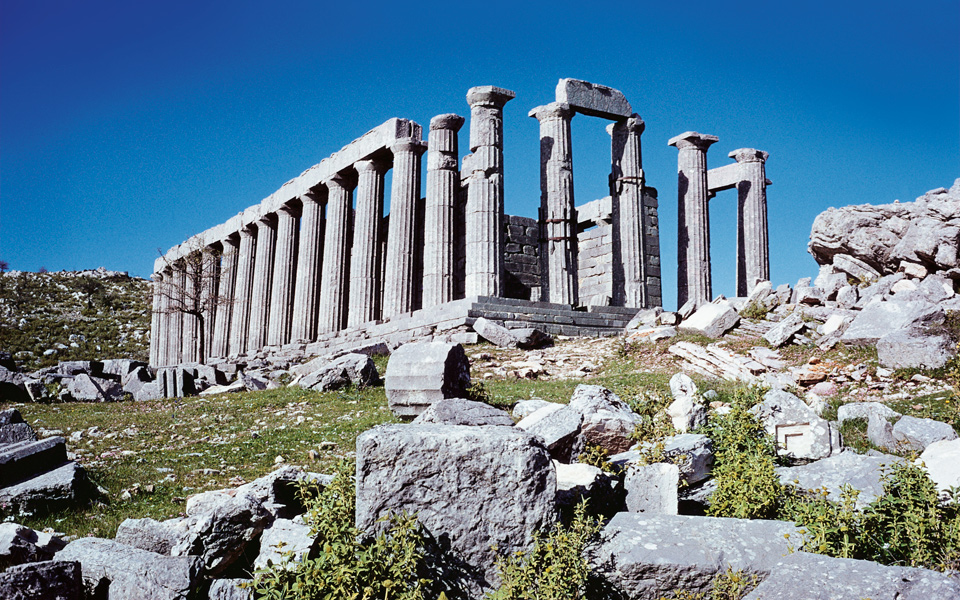
© Visualhellas.gr
1. Temple of Apollo Epicurius at Bassae, Peloponnese (inscribed in 1986)
The Temple of Apollo in the sanctuary at Bassae, the first Greek site to be inscribed on the UNESCO World Heritage List in 1986, is widely regarded as one of the best preserved monuments of Classical antiquity. Built in the second half of the 5th century BC in the remote Arcadian mountains of the Peloponnese, its isolation for nearly 1700 years ensured the main architectural features of the temple remained largely intact until its rediscovery in the 18th century, when it attracted artisans and antiquarians from across Europe.
The ancient traveller, Pausanias, who visited the monument in the mid-2nd century AD, attributed it to Iktinos, the famed architect of the Parthenon in Athens. It was built on top of an earlier temple erected by the inhabitants of Phigaleia in honor of the god Apollo Epicurius (“Apollo the helper”) to show their gratitude for saving them the plague.
The temple is the earliest example to combine all three architectural orders – Doric, Ionic, and Corinthian, including the oldest surviving Corinthian column. Its marble interior frieze, 31 m-long, depicting mythical battle scenes with Amazons (Amazonomachy) and Centaurs (Centauromachy), is among the finest examples of relief sculpture from the ancient Greece.
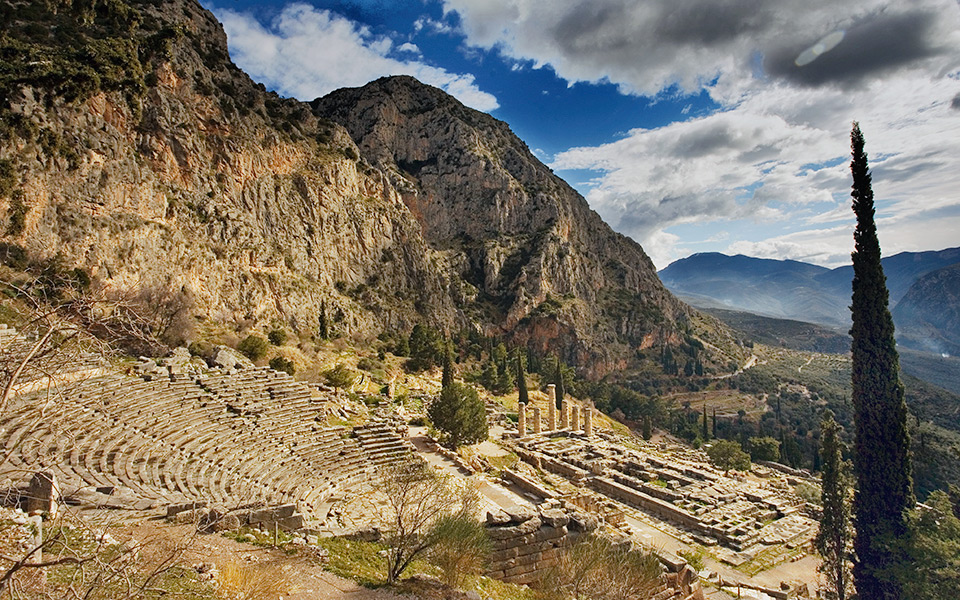
© Perikles Merakos
2. Archeological site of Delphi, central Greece (1987)
According to the ancient Greeks, the Panhellenic sanctuary of Delphi was the site of the omphalos, the “navel” of the world. Situated in the dramatic landscape of the Pleistos valley, surrounded by the foothills of Mount Parnassus, the site became a place of religious activity as early as the 2nd millennium BC, where Gaia (Mother Earth) was worshipped. The development of the sanctuary and divine oracle began in the 8th century BC with the establishment of the cult of Apollo, god music, harmony and light.
Apollo gave his oracles to pilgrims through the Pytheia, the priestess who resided in his temple. The sanctuary is bisected by the Sacred Way, a processional, ceremonial road lined by statuary groups, niches and treasuries (buildings for the deposition of gifts), erected by the various Greek city-states and kingdoms to commemorate specific events – political alliances, athletic triumphs, or military victories.
The sanctuary includes some of the best preserved buildings of the Archaic and Classical periods, representing all architectural orders and styles of Greek art. By the 6th century BC, Delphi was seen as the religious centre and symbol of unity of the ancient Greek world.
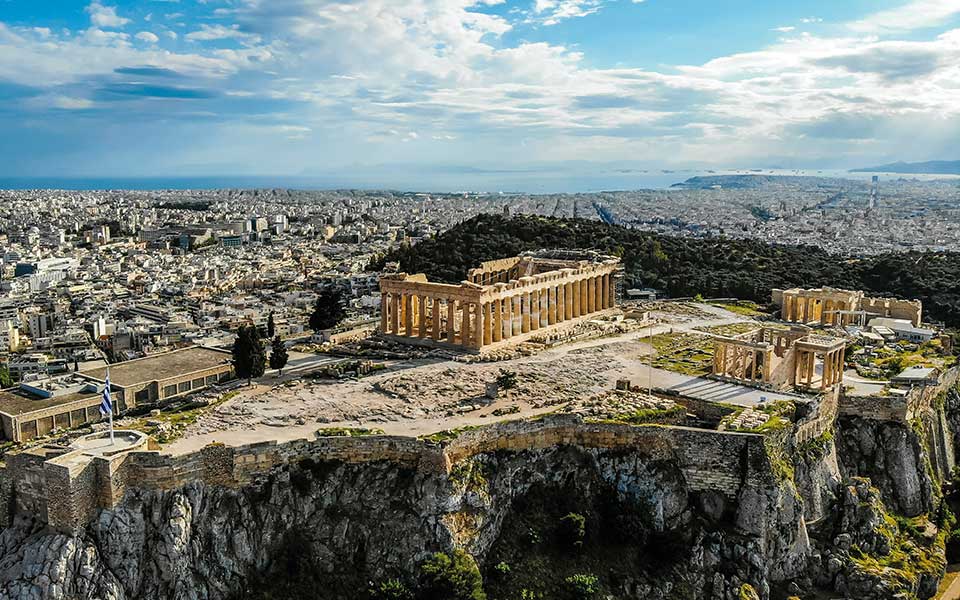
© Ministry of Culture and sports/Ephorate of Antiquities of the city of Athens, photo: Getty Images/Ideal image
3. Acropolis, Athens, Attica (1987)
The world-famous Acropolis is located atop a large, flat-topped hill that rises in the basin of Athens, some 150 meters above sea-level. Initially occupied in the Neolithic, it later became the site of a fortified palace complex (megaron) of a powerful Mycenaean kingdom in the 14th and 13th centuries BC. It gradually evolved into a religious sanctuary in the Archaic Period (776–480 BC), associated with the cult worship of the goddess Athena – the patron goddess of Athens.
Many of the earlier monuments on the Acropolis were destroyed by the Persians in 480 BC, after which an extensive rebuilding program was carried out in the second half of the 5th century BC, adorning the sacred citadel with new temples and public monuments made entirely of Pentelic marble.
Under the leadership of Pericles, the building program included the temple of Athena Nike (goddess of victory), the Propylaea (monumental gate), and the Parthenon, a masterpiece of Doric architecture, and the most iconic building of Classical Greece. Other monuments include the elegant temple of Erechtheion, dedicated to both Athena and Poseidon, god of the sea, and the Odeion of Herodes Atticus, a large Roman theater built on the southwest slope of the hill in 161 AD.
The Athenian Acropolis is directly associated with spirit and ethos of Classical Greece – the birthplace of democracy, philosophy, theatre, and the freedom of expression and speech that provide to this day the intellectual and spiritual foundations for Western social and political values. It represents more than a thousand years of ancient Greek culture and is one of the most densely-concentrated sites of Classical art and architecture in the world.
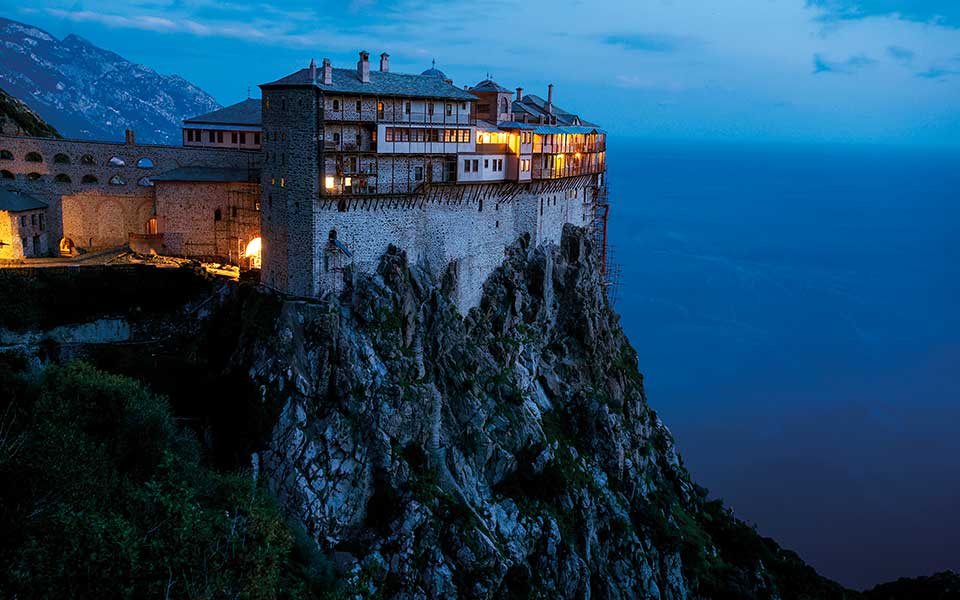
© Shutterstock
4. Mount Athos, Monastic Republic of Mount Athos (1988)
Situated on a long narrow rocky peninsula that juts into the northern Aegean Sea, Mount Athos (referred to in Greek as Agion Oros – “Holy Mountain”) has been an Orthodox Christian spiritual centre since the 10th century. Covering an area of just over 335 square kilometers, it is today home to 20 active monasteries and their subsidiary establishments, including kellia and kathismata (medieval living units or “settings” operated by over 2,000 monks).
An autonomous self-governing entity since Byzantine times, its first constitution was signed in 972 AD by the emperor John I Tzimiskes. The Holy Mountain is forbidden to women and children, and its rugged landscape is the setting of traditional monastic farming practices, which maintain populations of rare plant species.
The monasteries themselves present the typical layout of Orthodox monastic establishments – square, rectangular or trapezoidal main buildings flanked by fortified towers. Each monastery is a veritable conservatory of artistic masterpieces, including medieval wall paintings, icons, gold objects, embroideries, and illuminated manuscripts.
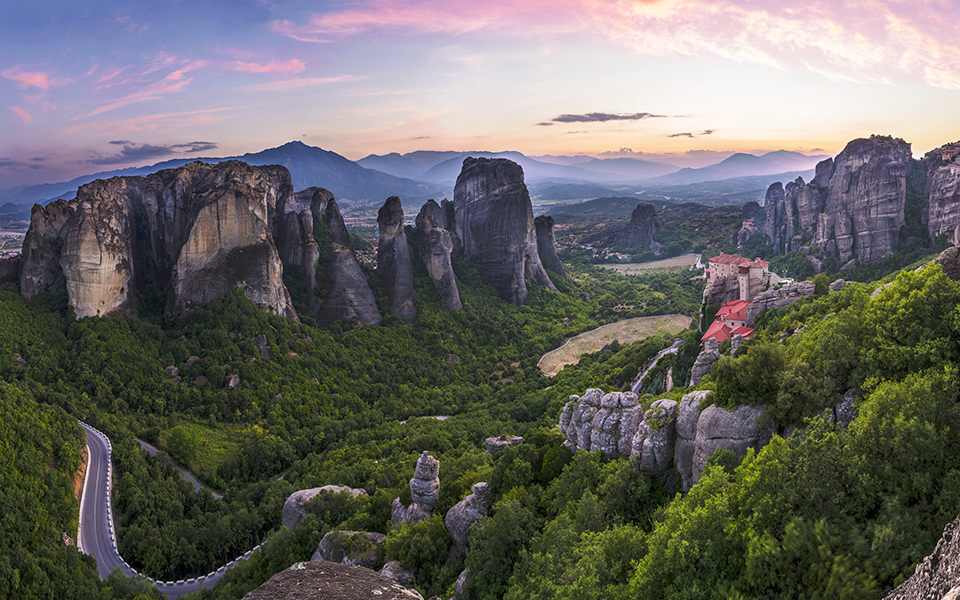
5. Meteora, Thessaly (1988)
Set beside the Pindos Mountains in western Thessaly, the dramatic landscape of Meteora is dominated by huge columns or “pillars” of rock rising precipitously from the ground. It is home to one of the largest concentrations of Eastern Orthodox monasteries in the world, second in importance to Mount Athos.
Monks began to settle these “columns in the sky” from the 11th century onwards. At its peak in the 16th century, there were as many as 24 functioning monasteries in the area, administered by separate orders of monks and nuns.
Perched atop the high rocks and virtually inaccessible, the flourishing of monastic life at this time was representative of the great revival of the eremitic ideal – literally “in the desert” – hermits seeking a life of quiet seclusion and prayer. Access to the monasteries was deliberately difficult, requiring long ladders or nets to haul up both supplies and people. This required a leap of faith – the ropes were replaced, so the story goes, only “when the Lord let them break.”
Much of the monastic architecture at Meteora is “Athonite,” resembling the buildings on Mount Athos. Their 16th-century frescoes mark a key stage in the development of post-Byzantine painting.
Today, only six monasteries remain active, with a population of around 50 monks and nuns.
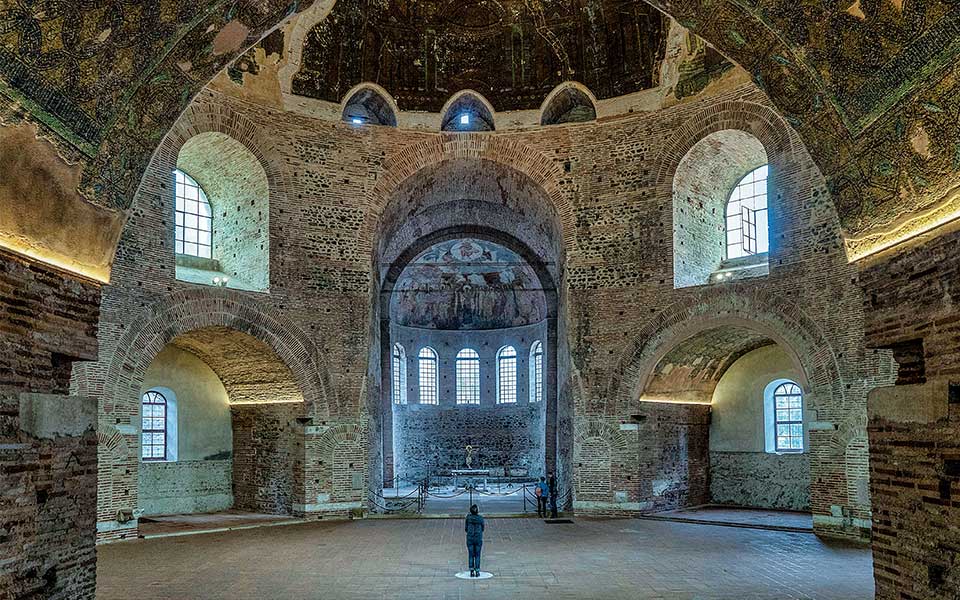
© Perikles Merakos
6. Paleochristian and Byzantine monuments of Thessaloniki, central Macedonia (1988)
Founded in 315 BC by king Cassander of Macedon, one of Alexander the Great’s diadochi (“successors”), the provincial capital and sea port of Thessaloniki was one of the first bases for the spread of Christianity.
Its monuments include several fine churches and basilicas, constructed from the 4th to the 15th century, representing a typological series of architectural designs spanning the entire timeline of the Byzantine period. Also included are the city’s 4 kilometer-long defensive walls from the 4th and 5th centuries and the famous Rotunda, originally intended to be the mausoleum of the pagan Roman emperor Galerius in the early 4th century, and later converted into the Church of Aghios Georgios.
Throughout the Byzantine era, Thessaloniki constituted an important cultural and political center. Its monuments reveal an artistic “halfway house” between Rome in the west and Constantinople in the east, and its wall paintings, mosaics and frescoes, especially those in the Churches of Hosios David and Aghios Demetrios, are among the best examples of early Christian art.
The Church of Aghios Demetrios, the patron saint of Thessaloniki, was built on the site of an ancient Roman bathhouse, where Demetrios himself, an early Christian martyr, was said to have been held prisoner and killed.
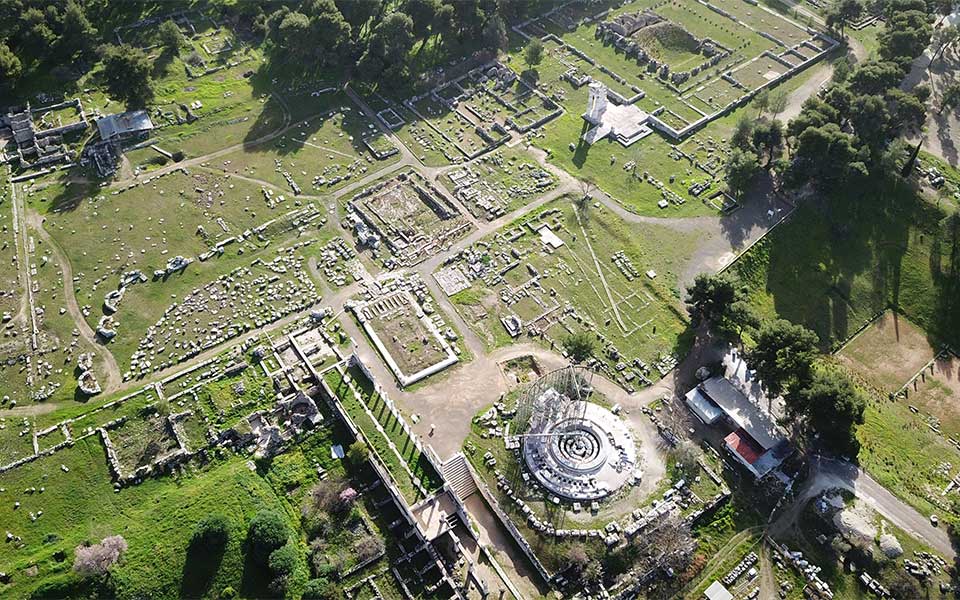
© Shutterstock
7. Sanctuary of Asklepios at Epidaurus, Peloponnese (1988)
In a small valley on the Argolid peninsula, the Sanctuary of Asklepios became one of the most important health centers in the ancient world. Established in the city-state of Epidaurus in the northeast Peloponnese, the sacred shrine to the god of medicine developed out of an earlier 8th century BC cult of Apollo (“Apollo Maleatas”), and an even earlier shrine to a Bronze Age healing deity from the 16th century BC.
The sanctuary of Asklepios, whom mythological tradition established as the son of Apollo, included the Temples of Artemis and Asklepios, near the fabled site of his birth, the mysterious Tholos, with its ornate astronomical floor design, and the famous theater – all masterpieces of Classical Greek architecture.
Spread over two terraces and surrounded by forested landscape, pilgrims and patients would come seeking help from the resident priests and physicians. The construction of ancillary buildings and medical facilities, including a large dormitory for patients (enkoimeterion), a ceremonial banqueting hall (hestiatorion), and baths, provide glimpses into the practices of healing cults of the time.
The ancient theater of Epidaurus, still in use today, was celebrated by Pausanias for its architectural symmetry and design, and for its exceptional acoustics.
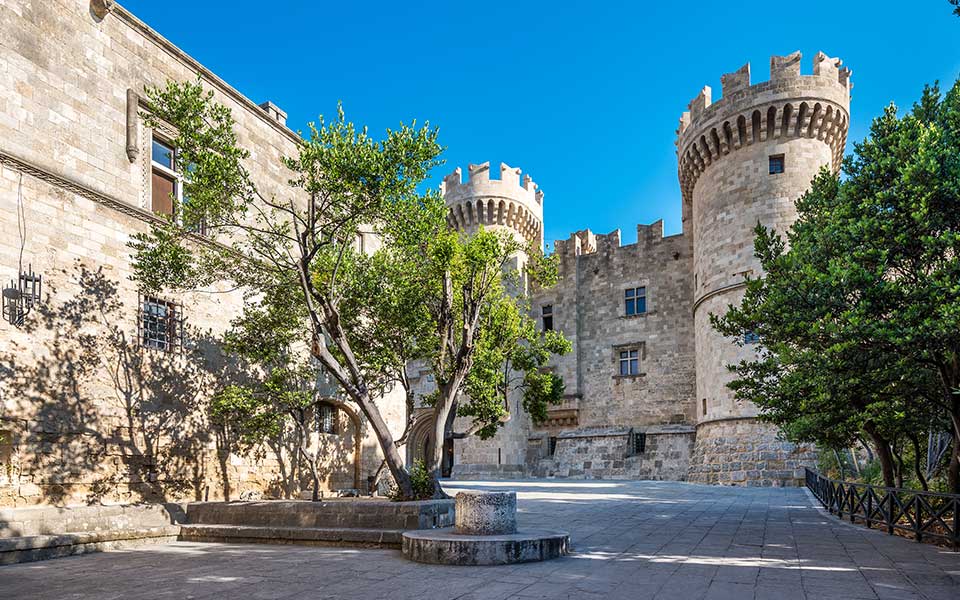
© Shutterstock
8. Medieval City of Rhodes, south Aegean (1988)
From 1309 to 1523 AD, the island of Rhodes was occupied by the Order of St John of Jerusalem (the famed Knights Hospitaller), establishing it as an island fortress following their expulsion from the Holy Land in 1291.
They embarked on an ambitious building program, including the Palace of the Grand Masters, the Great Hospital, and a 4 kilometer-long defensive wall, partly erected on the remains of an earlier Byzantine enclosure. The town itself was transformed into a stronghold, able to withstand brutal sieges from the Sultan of Egypt in 1444 and the Ottoman Sultan Mehmet II (“the Conquerer”) in 1480.
The urban ensemble within the old city walls, including the picturesque Street of the Knights, represents some of the finest examples of Gothic architecture in the Mediterranean. The high town to the north, originally separated from the lower town to the southwest by a fortified wall, was entirely built by the Knights.
The Order was organized into eight langues or “tongues” (languages) – one each for the Crowns of Aragon, Auvergne, Castile, the Kingdom of England, France, the Holy Roman Empire, Italy and Provence. Each langue had its own seat or “inn.”
Following a six-month siege in 1522, Rhodes finally fell to the Ottoman Sultan Suleyman II, and the Knights withdrew further west, finally settling on the island of Malta in 1530. In the immediate aftermath, the Ottomans converted many of the churches into Islamic mosques.
Today, the Gothic architecture of the medieval city coexists with the mosques, public baths and other buildings from the Ottoman period, and earlier Byzantine constructions.
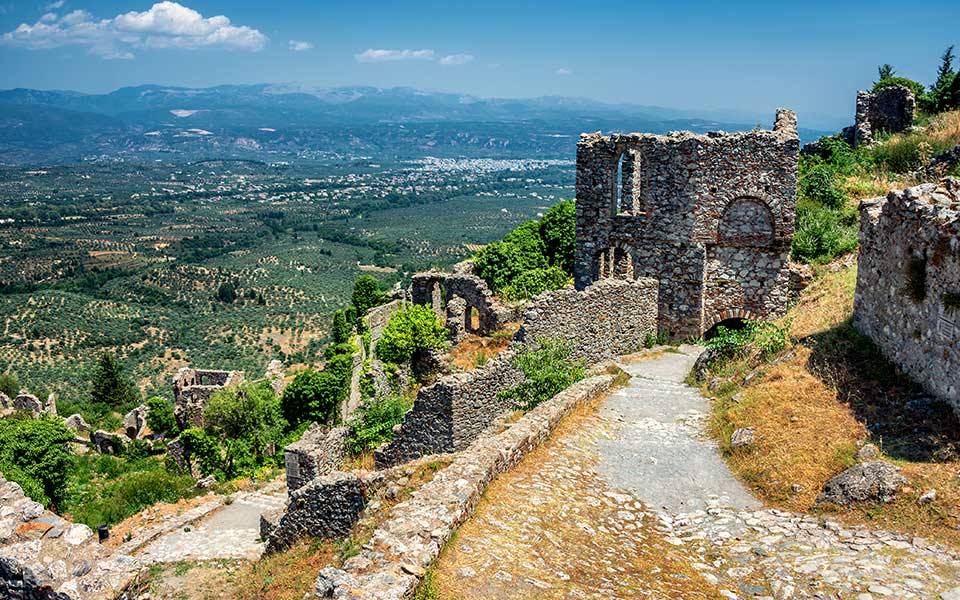
© Shutterstock
9. Archeological site of Mystras, Peloponnese (1989)
The ruins of the medieval city of Mystras, the “Wonder of the Morea,” are located on the slopes of Mount Taygetus in the southeast Peloponnese. Built around a Frankish fortress erected in 1249 by the Prince of Achaia, William II of Villehardouin, the settlement developed down the side of a 620 meter-high hill overlooking Sparta.
In 1262, the Franks surrendered the fortified city to the Byzantines, where it became the center of Byzantine power in southern Greece, first as the base of the military governor and then, from 1348, as the seat of the Despotate of Morea.
During this time, Mystras attracted many inhabitants and institutions, ushering in a period a great prosperity and a flourishing of late Byzantine culture. The bishopric was transferred from nearby Sparta, with its cathedral, the Metropolis of Aghios Demetrios, built after 1264. Many monasteries and churches were constructed in 14th and 15th centuries, heavily influenced by the “Helladic” school of Byzantine architecture as well as the eclectic styles and designs of Constantinople.
During the Palaeologan Renaissance era, the last dynasty to rule the Byzantine empire, the beauty of Mystras’ churches, covered with frescoes and fine examples of Romanesque and Gothic art, and the fame of its libraries, was a powerful draw for Christian scholars, Neo-Platonic philosophers and intellectuals.
The city was later occupied by Turks and then the Venetians, before finally being abandoned in 1832.
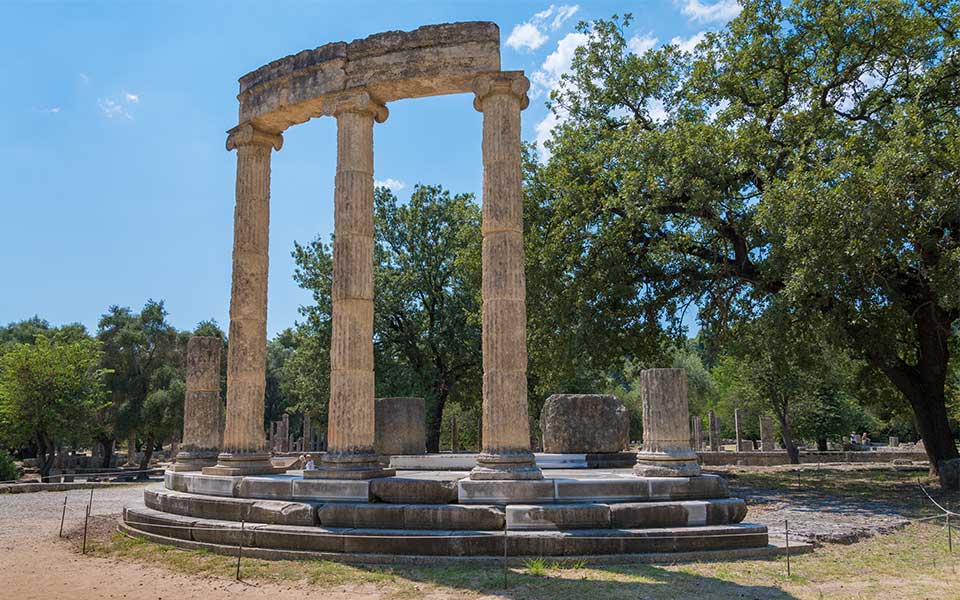
© Shutterstock
10. Archeological site of Olympia, western Greece (1989)
The sanctuary of Olympia in the northwest Peloponnese became a center for the worship of Zeus as early as the 10th century BC, but its first discernible buildings were erected in the Archaic period, in the 7th and 6th centuries BC.
The center of the Sanctuary, an area known as the Sacred Grove, or “Altis,” comprises a number of Archaic and Classical Greek monuments, including the main temples of Hera (or Heraion/Heraeum) and Olympian Zeus, both masterpieces of Doric architecture, the shrine of Pelops (the Pelopion – “drenched in glorious blood”), and the site of the great sacrificial altar of Zeus, king of the gods.
The famous sculptor, Pheidias, sculptor the Parthenon friezes in Athens, erected a 12.4 meter-tall gold-and-ivory cult statue of Zeus in the third quarter of the 5th century BC, one of the Seven Wonders of the Ancient World. The remains of Pheidias’ workshop can still be seen beneath the foundations of an early Byzantine church.
Olympia became a great Panhellenic sanctuary and the site of the ancient Olympic Games, beginning in 776 BC. Alongside the sanctuary and the stadium were a host of administrative buildings, hostels, bathhouses, and sporting structures (Palaestra and Gymnasium) used for the preparation and celebration of the Games, held every four years from the 8th century BC to 393 AD, when the Christian Roman emperor Theodosius passed laws restricting pagan religious practices and events.
The Olympic Games embodied the high ideals of Hellenic humanism: physical and mental harmony, and peaceful and noble competition between free and equal men.
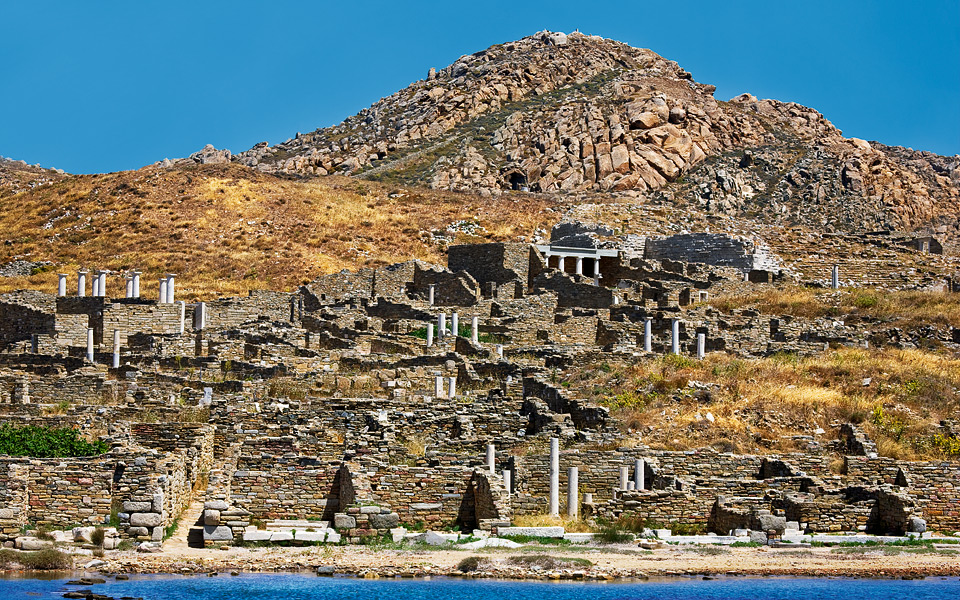
© Shutterstock
11. Delos, south Aegean (1990)
By the 9th century BC, the once insignificant (adelos) Delos, a tiny rocky island in the middle of the Cyclades, was on its way to becoming one of the most important religious centers in the ancient world. According to legend, it was the birthplace of Apollo-Sun, god of daylight, and his twin sister Artemis-Moon, goddess of night light. The establishment of the Apollonian sanctuary on the island, including three cult temples, made it a popular draw for pilgrims.
A mere four-square kilometers in size, Delos bears faint traces of early settlement in the mid-3rd millennium BC but it was during the Archaic and Classical periods when it acquired its Panhellenic character.
The steady flow of pilgrims enabled the sacred island to become a trading emporium, where rich merchants, financiers and ship-owners gradually settled, attracting a large cosmopolitan population. Over time, the island was covered in a motley collection of architectural monuments, including richly-decorated public buildings, smaller sanctuaries to foreign gods (Egyptian Isis, Sarapis, and Anubis, and Syrian Hadad and Atargatis), and the famous treasury of the Athenian-led Delian League.
By around 90 BC, the population of the island reached a staggering 30,000 inhabitants, barely conceivable considering its minute size. By that point, it had become one of the richest commercial hubs in the Mediterranean and the centre of the ancient slave trade.
The island quickly fell into decline following the Mithridatic Wars (88–63 BC), a series of three bloody conflicts fought between Rome and the Pontic empire in the Black Sea region. It was eventually abandoned.
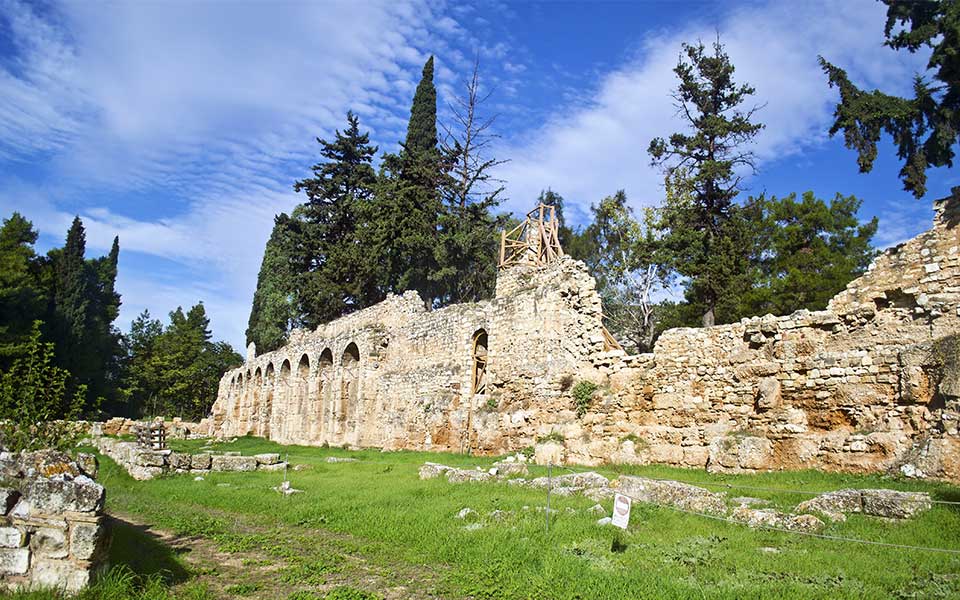
© Shutterstock
12. Monasteries of Daphni, Hosios Loukas and Nea Moni of Chios, central Greece, Attica, and the north Aegean (1990)
Although geographically distant from each other, these three monasteries of the Middle Byzantine period (the first in Attica, the second in Boeotia, the third on the island of Chios) share many of the same architectural features.
The still active monasteries are among the most outstanding examples of Middle Byzantine religious art and architecture in Greece. All three churches are built on a cross-in-square plan with a large dome, defining a Greek cross-octagonal space. In the 11th and 12th centuries, they were decorated with some of the finest marble sculptures and mosaics of the period.
Their interior decorations and eye-catching mosaics are especially characteristic of the “Second Golden Age” of Byzantine art, painted on top of a glassy layer of gold-ground tesserae (small cubes) to reflect the light, giving the artworks an unusually bright color. In Byzantine theology, church buildings were a symbol of the Christian universe, intended to reflect the splendor of heaven.
According to scholars, the burial crypt beneath Hosios Loukas contains the most complete program of wall paintings from the period. Pilgrims would often sleep in the crypt – a practice called incubation – with the intention of experiencing a divinely-inspired dream or being cured of an illness.
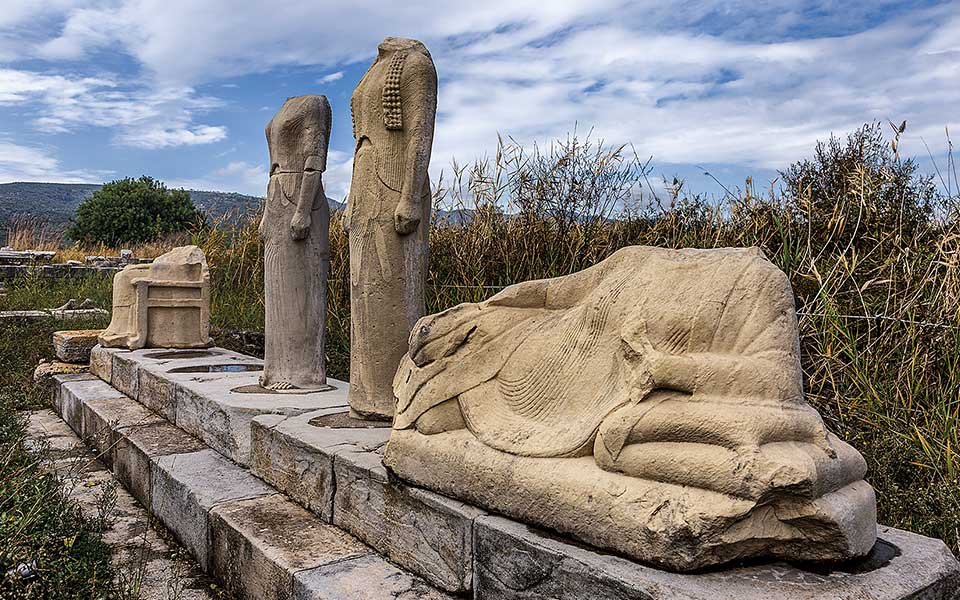
© Perikles Merakos
13. Pythagoreion and Heraion of Samos, north Aegean (1992)
Due to its geographical position in the eastern Aegean, the island of Samos became an important commercial and naval power in the ancient Greek world. The earliest finds date back to the 5th and 4th millennia BC, when Neolithic farmers established small settlements on the island, but it was much later, in the 10th century BC, when it began its steady rise to prominence.
Located at the maritime crossroads linking mainland Greece and the Aegean islands with Anatolia, Samos emerged as a powerful city-state in the Archaic period and quickly established trading colonies on the coasts of Cilicia and the Black Sea, as well as settlements further afield in North Africa. Heavily forested and pitted with high mountains (“Samos” derives from the root sama, meaning “high”), the island was renowned for its fine wines, traded across the Mediterranean, and for its powerful navy – one of the largest in Greece.
The ancient fortified port city of Pythagoreion lies in the northeast of the island, defined by two surrounding mountains, Kerkis (or Kerketeas) and Ambelos (or Karvouni). One of its most spectacular architectural features is a 1 kilometer-long tunnel aqueduct, constructed in the 6th century BC, which brought water to the city. Excavations have further revealed paved streets, public squares, villas with superb mosaic floors, an agora, and an extensive building program of bathhouses, temples, and athletic facilities.
The worship of the goddess Hera on Samos can be traced back to the Late Bronze Age in the form of a stone altar, but the great Temple of Hera (Heraion) has its origins in the 8th century BC. It was the first Greek temple to be one hundred feet in length (Hecatompedos) and built almost entirely of stone. Its three successors, built in the 7th and 6th centuries BC, were progressively more colossal and spectacular; the final incarnation measuring 55 m by 108 m and surrounded by a peristyle of 155 columns 20 meters-high.
Pythagoreion and the Heraion made Samos the cultural and artistic epicenter of the Ionic world. It was the birthplace of some of the greatest thinkers of the Classical world, including philosopher and mathematician Pythagoras, the philosopher Epicurus, and the astronomer Aristarchus the Samian, who established the first known heliocentric theory of the universe in the 4th century BC.
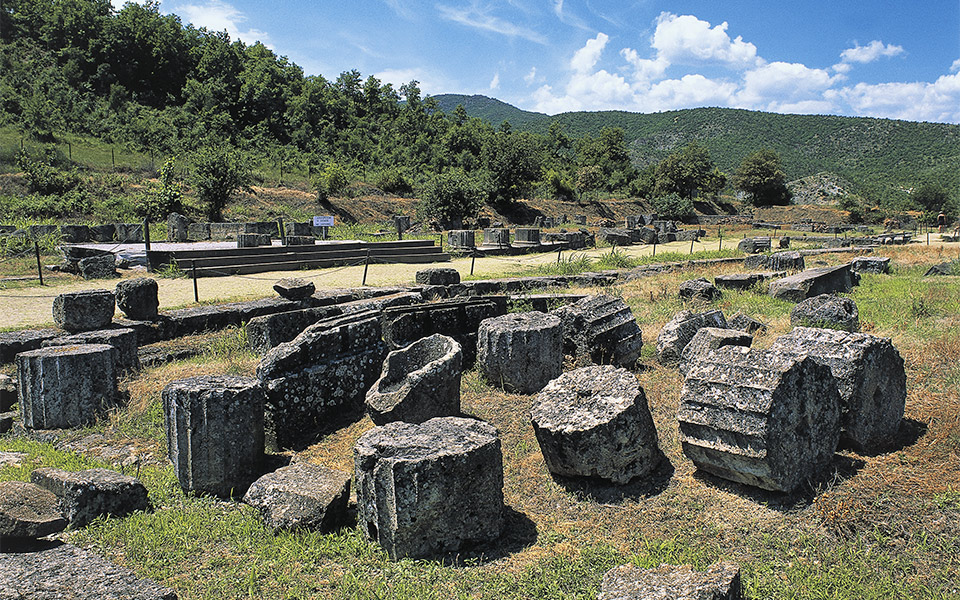
© Shutterstock
14. Archaeological Site of Aigai (modern name Vergina), central Macedonia (1996)
The ancient city of Aigai, the first capital of the Kingdom of Macedon, climbs the slopes of the Pierian Mountains in northeast Greece. It was discovered in the mid-19th century near the modern village of Vergina, archaeologists being drawn to the site by the hundreds of tumuli (burial mounds) dotted around the surrounding landscape. Subsequent excavations revealed the remains of a monumental palace from the mid-4th century BC, a theater, religious sanctuaries, city walls, and a vast royal necropolis.
The name of the city, “Aigai,” means “goat-pasture,” and alludes to the stock-breeding that formed the mainstay of the ancient Macedonian economy. Defined by the Pierian Mountains to the south and the rivers Haliakmon to the west and north, and Askordos to the east, excavations of the tumuli established a date range from the 11th to the 2nd centuries BC, with the area first rising to prominence in the Early Iron Age (1100–700 BC).
Aigai became the seat of the royal court of the Argead dynasty, whose legendary ancestors included Hercules. Their greatest period of prosperity and political power came in the mid-4th century BC during the reign of king Philip II (359–336 BC), the father of Alexander the Great.
Philip initiated a major building program, including the construction of a luxurious palace with mosaic floors and ornate decorations, one of the largest and most impressive buildings of late Classical Greece. A theater was incorporated into the same architectural plan, running along on the same axis, thus enabling the royal family to watch performances from their balcony.
In the late 1970s, Greek archaeologist Manolis Andronikos became convinced that a hill called the “Great Tumulus” concealed the tombs of the Macedonian kings. During a six-week excavation in 1977, the discovery of four tombs, two of which were undisturbed, caused a worldwide sensation.
Tomb II, in particular, with its well-preserved wall-paintings and grave-goods, resembled the interior of a palace or temple, full of gold-embellished weapons, gold oak wreaths and diadems, silver and bronze vessels (hydria), and the cremated remains of Philip II himself in a golden casket (larnax).
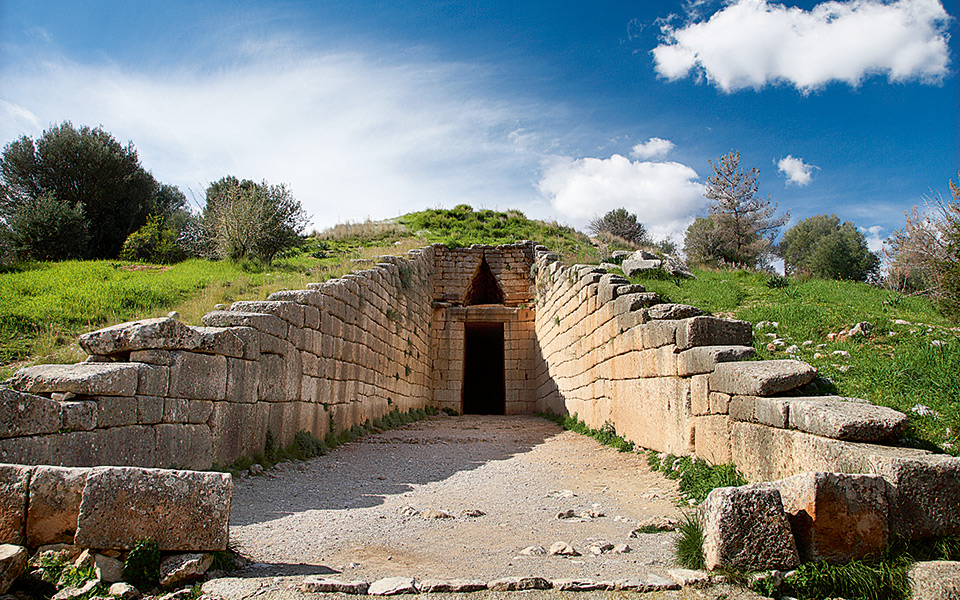
© Olga Charami
15. Archaeological site of Mycenae and Tiryns, Peloponnese (1999)
The archaeological sites of Mycenae and Tiryns, located 20 kilometers apart in the Argolid region of the northeast Peloponnese, are the remnants of the two most important centers of Mycenaean Greece, a Late Bronze Age culture that dominated the eastern Mediterranean from the 15th to the 12th centuries BC.
The citadels are indisputably linked to the great Homeric epics, the Iliad and the Odyssey, playing an important role in the development of Classical Greek culture, and, over the course of three millennia, inspiring numerous poets, writers and artists.
Their imposing ruins represent important examples of monumental palatial architecture. Massive “cyclopean” fortification walls, so-called because the later Greeks believed they had been built by Cyclops, mythical giants from Lycia, enclosed palace complexes that were at the heart of a highly centralized administrative system.
The palace rulers exerted control over the livestock and agricultural production of the surrounding settlements, and established trade networks with neighboring states and kingdoms. These transactions have been preserved on Linear B tablets, a syllabic script that pre-dates the Greek alphabet.
Overlooking the Argolid Plain, Mycenae was the kingdom of the mythical Agamemnon and his family, a favorite subject of epic poetry, art, and Classical Greek tragedy (the Oresteia trilogy by Aeschylus).
Excavations in the 19th and 20th centuries revealed significant stages of monumental architecture, grave circles containing beautifully preserved artifacts and golden funerary masks (including the famous “Mask of Agamemnon”), corbelled tholos (or “beehive”) tombs, and the iconic Lion’s Gate – the monumental entranceway to the citadel.
The citadel of Tiryns is situated 20 kilometers southeast of Mycenae on a low hill near the inlet of the Argolic Gulf. Its cyclopean walls, built of stones even larger than those of Mycenae, are up to 8 meters thick and 13 meters high – an extraordinary feat of Bronze Age engineering.
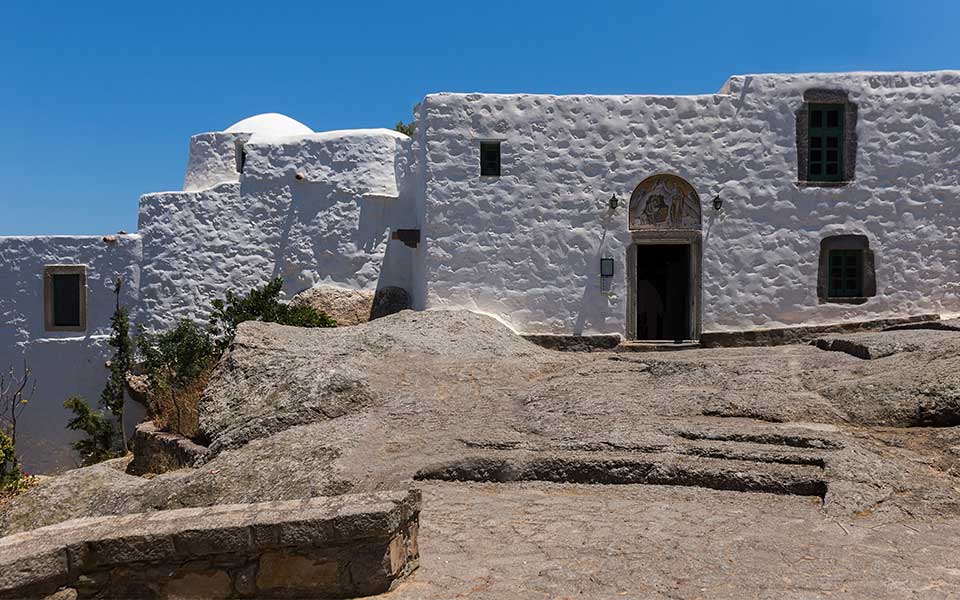
© Shutterstock
16. The Historic Centre (Hora) with the Monastery of St John the Theologian and the Cave of the Apocalypse on the island of Patmos, south Aegean (1999)
According to Christian tradition, the small island of Patmos in the Dodecanese is where St John the Theologian (also St John of Patmos) composed both his Gospel and the Apocalypse at the end of the 1st century AD. A millennium later, an Orthodox monastery dedicated to him was founded there in 1088 by Hosios Christodoulos Latrinos, and has been an important seat of learning and pilgrimage for Christians ever since.
The monastery has the external appearance of a heavily fortified polygonal castle, with imposing towers and crenellated walls. Within the enclosure lies an architectural ensemble of churches, chapels, and monastic cells. These include the Katholikón, the main church of the monastery, the Chapel of Panaghia, and the refectory. Housed within the complex is a remarkable collection of early Christian manuscripts and icons, as well as important mural paintings and other church furnishings.
The old settlement of Hora, built around the hill-top fortifications of the monastery, contains many religious and secular buildings from the later Byzantine and Ottoman periods, when it thrived as an important trading center.
Nearby, the famous “Cave of the Apocalypse” is reputed to be the place where St John dictated the Book of Revelation and his Gospel to his disciple Prochoros.
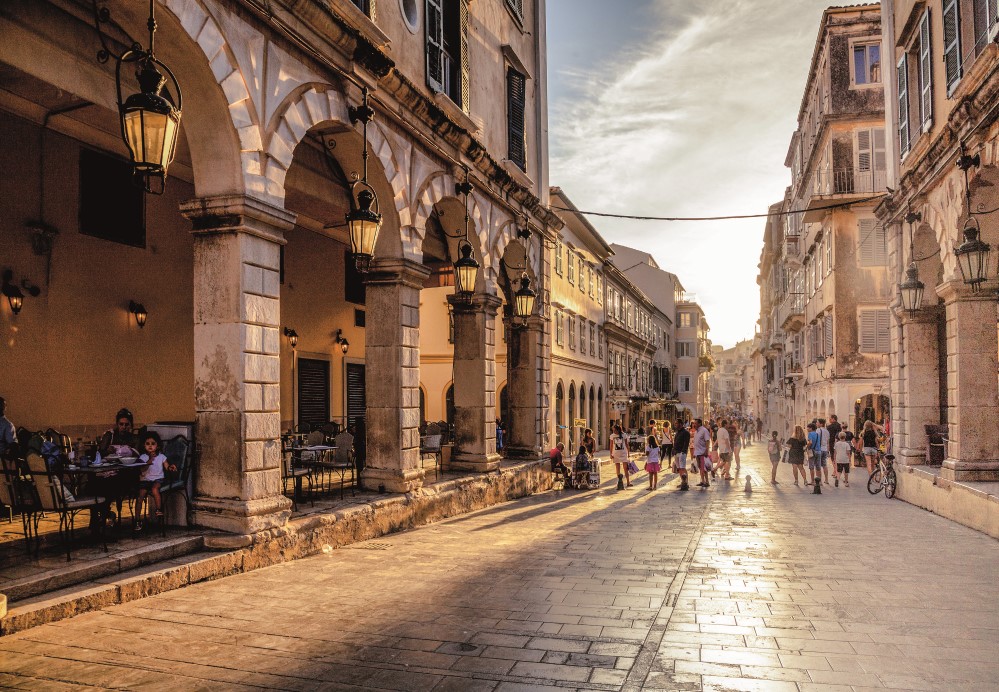
© Visualhellas.gr
17. Old Town of Corfu, Ionian islands (2007)
The island of Corfu commands a strategic position at the southern entrance of the Adriatic Sea. The urban and port architecture of the Old Town, on the eastern side of the island, is dominated by well-preserved Venetian fortresses and fortification walls, largely designed by the famous architect and urban planner, Michele Sanmicheli (1484–1559), and an ensemble of neoclassical houses, many dating from the period of British rule in the early 19th century.
Corfu was often fought over by various city-states and alliances in the Classical and Hellenistic periods, and changed hands several times between ruling dynasties of the Byzantine empire. From the end of the 14th century, the island became part of the Venetian thalassocracy, a powerful maritime republic that controlled large areas of the Adriatic Sea.
Over the course of the next four centuries, from 1386 to 1797, the Old Town was crucial for the defense of Venice’s maritime interests in the face of Ottoman aggression in the eastern Mediterranean. It withstood two brutal sieges by the Ottomans in 1537 and 1716 respectively, and was widely seen as a bastion of Western resistance against the Ottoman tide.
The island then briefly passed to the French (for two years) and then into British hands in the 19th century, eventually becoming part of the modern Greek state on March 29, 1864.
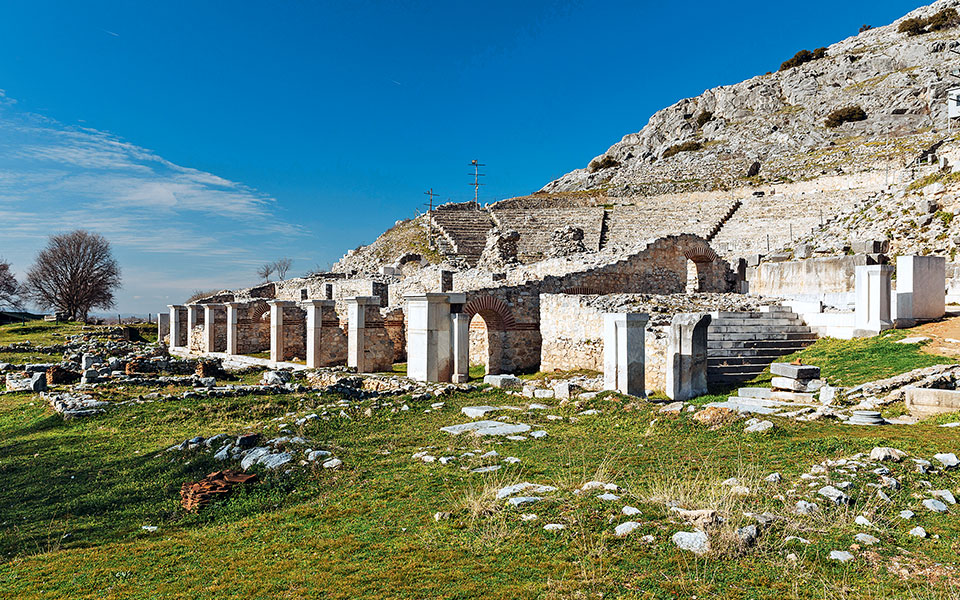
© Nikolas Mastoras
18. Archaeological Site of Philippi, eastern Macedonia and Thrace (2016)
Philippi was founded in 356 BC by Philip II of Macedon. The city, located in northeast Greece, was an important stop on the Via Egnatia, an ancient road that linked Europe with Asia, and quickly developed into a vibrant Hellenistic city with a large theater, fortification walls and monumental gate, and a funerary heroon (temple).
In the decades following the landmark Battle of Philippi in 42 BC, where the combined army of Brutus and Cassius, the assassins of Julius Caesar, was defeated by the forces of Marc Anthony and Octavian, the city developed into a “small Rome.” The battle marked the end of the Roman Republic, and, in 31 BC, Octavian, now the most powerful man in Rome, re-founded the city as a colony, Colonia victrix Philippensium, receiving settlers from Italy. It was further adorned with a large Roman forum, public buildings, and a monumental terrace with temples.
The city became an important center for early Christianity following the visit of the Apostle Paul in 49–50 AD. The remains of 4th–6th century domed basilicas and an octagonal church are testimony to its importance as a Metropolitan see, and the site remains an important place of pilgrimage to this day.
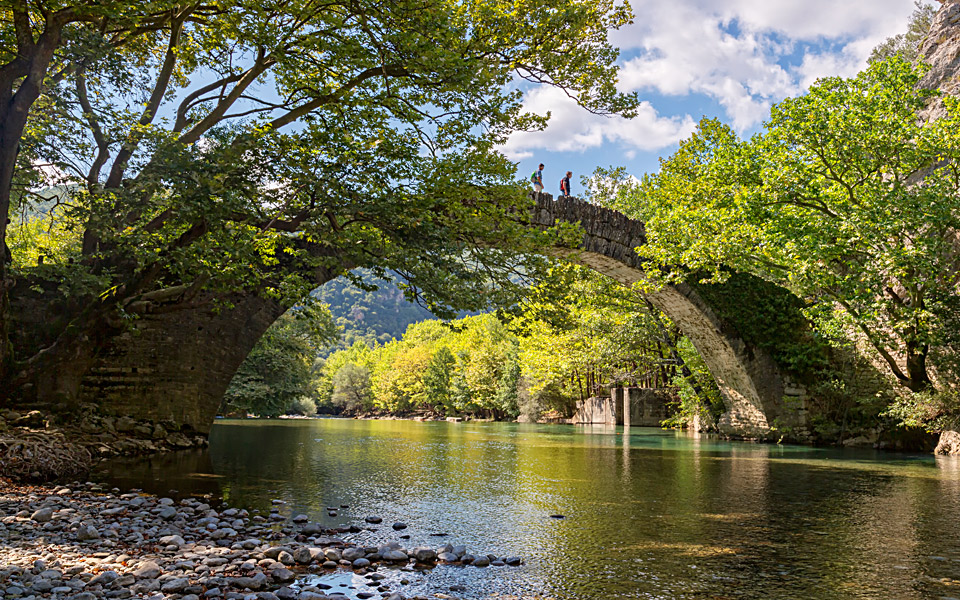
© Perikles Merakos
19. Zagori Cultural Landscape, Epirus (2023)
The Zagori region of Epirus, northwest Greece, is the country’s latest entry on the UNESCO World Heritage List. Renowned for its traditional stone-built villages and arched bridges, nestled amid breathtaking scenery, Zagori is also home to a wealth of intangible cultural heritage, including traditional music, religious festivals, and local traditions, influenced by other areas of the Balkans, Central Europe, and Asia Minor. It is the first region in Greece to be inscribed on the prestigious World Heritage List in the category of “cultural landscapes.”
Extending along the rugged western slopes of the Pindus Mountain Range, the 45 villages, collectively known as the “Zagorochoria,” are noted as outstanding examples of traditional vernacular architecture, dating back to the 17th and 18th centuries. The villages, with their distinctive rectangular houses, are typically organized around a picturesque central square called a “mesochori” (village center), with a large church, plane tree, and public fountain. Connected by an extensive network of cobblestone paths (“skales”), adapted to the topography, the villages served as a vital trading hub that linked the Adriatic and Ionian coasts during the Ottoman era.
Of the 160 bridges that were built in the 18th and 19th centuries, around 100 are still standing, including the famous Kokkori bridge. According to the UNESCO criterion, the stonework showcased in the bridges, buildings, and pathways represents an architectural tradition that is unique to the Zagori region.
Today, visitors are drawn to the area for its outstanding natural beauty, dramatic geological formations, thick forests, and undisturbed rivers and ravines, the most famous of which being Vikos Gorge. It is especially popular for outdoor activities, including hiking and rafting.

